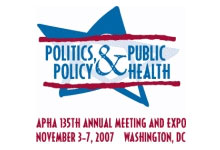In this Section |

153054 Knowledge, attitudes, and self-report practices of sun safe behaviors in fourth grade students and their parentsMonday, November 5, 2007
Background: Repeated exposures during childhood to ultraviolet (UV) radiation, a known carcinogen to the skin, have a cumulative effect on the risk of developing melanoma later in life. Children and parents' knowledge and attitudes related to sun safety directly influence their sun-related behaviors. Methods: Fourth grade students (N=84) and their parents (N=95) in two suburban elementary schools in the Southeastern United States completed baseline self-report surveys on knowledge, attitudes and behaviors related to sun safety. Data were available for 84 matched parent-student pairs. Statistical analysis included descriptive statistics, chi-square analysis, and Fischer's exact test (á=0.05). Results: Eighty-four percent of parents reported they talk with their child about sun safety at least once a year. While 72.6% of students were able to correctly identify “sun safe” behaviors, few students reported that they “often” or “very often” wear clothes that cover their skin (13.1%), a hat (17.9%), or sunglasses (15.5%) while out in the sun. Most students (73.8%) reported sunscreen use “only at the beach, lake, or pool.” There was no significant relationship between child knowledge of sun safety and their behaviors or the frequency of parent teaching and child behavior. Conclusions: These data reveal students have an understanding of the risks of sun damage and what sun safe behaviors are; however, results also show that students do not always practice these behaviors. This underscores the need for a more comprehensive school-based sun-safe education program for students and parents that includes reinforcement of these important practices.
Learning Objectives: Keywords: Cancer Prevention, School-Based Programs
Presenting author's disclosure statement:
Any relevant financial relationships? No I agree to comply with the American Public Health Association Conflict of Interest and Commercial Support Guidelines, and to disclose to the participants any off-label or experimental uses of a commercial product or service discussed in my presentation.
See more of: School Health Posters: Modern Day Challenges
See more of: School Health Education and Services |
